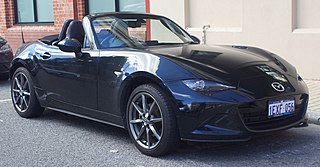
A roadster is an open two-seat car with emphasis on sporting appearance or character. Initially an American term for a two-seat car with no weather protection, usage has spread internationally and has evolved to include two-seat convertibles.
Quincy David "Quin" Epperly was an American racing car constructor. He was born in Floyd, Virginia, to John Wesley and Iowa Texas Epperly. After completing a correspondence course in "Theory of Aircraft Construction", Epperly moved to Southern California in 1940 to work for Lockheed and Pacific Airmotive. During the war, he joined the Coast Guard Reserve to spend evenings after work on watch at the Wilmington Coast Guard Patrol Base.
Frank Peter Kurtis was an American racing car designer. He designed and built midget cars, quarter-midgets, sports cars, sprint cars, Indy cars, and Formula One cars. He was the founder of Kurtis Kraft.
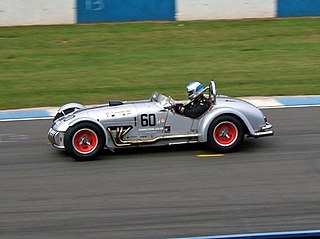
Kurtis Kraft was an American designer and builder of race cars. The company built midget cars, quartermidgets, sports cars, sprint cars, Bonneville cars, and USAC Championship cars. It was founded by Frank Kurtis when he built his own midget car chassis in the late 1930s.
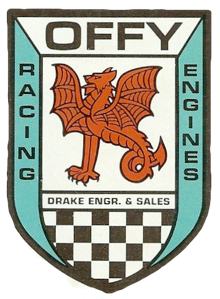
The Offenhauser Racing Engine, or Offy, is a racing engine design that dominated American open wheel racing for more than 50 years and is still popular among vintage sprint and midget car racers.

Troy Lynn Ruttman was an American race car driver. He was the older brother of Jimmy Ruttman, and NASCAR driver Joe Ruttman.
John James McGrath was an American racecar driver. McGrath died in an accident at Bobby Ball Memorial, he lost control of his car at Turn 3, crashed and flipped, dying instantly.
Fred H. Offenhauser, Jr., was a machinist and self taught automotive engineer who developed the Offenhauser racing engine, nicknamed the "Offy", which dominated competition in the Indianapolis 500 race for decades. He also built the Novi engine, which was designed by Bud Winfield and Leo Goossen.
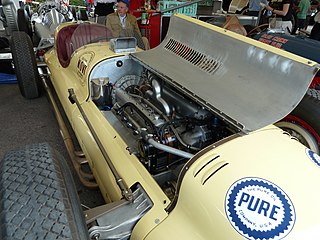
The Novi engine is an American dual overhead cam supercharged V8 engine used in racing cars in the Indianapolis 500 from 1941 to 1966. Designed by Bud Winfield and Leo Goossen, it was built by Fred Offenhauser.

The Indianapolis Motor Speedway Museum is an automotive museum on the grounds of the Indianapolis Motor Speedway in Speedway, Indiana, United States, which houses the Indianapolis Motor Speedway Hall of Fame. It is intrinsically linked to the Indianapolis 500 and Brickyard 400, but it also includes exhibits reflecting other forms of motorsports, passenger cars, and general automotive history. In 2006, it celebrated its 50th anniversary. The museum foundation possesses several former Indianapolis 500 winning cars, and pace cars, and they are regularly rotated onto the display floor exhibits.

Indianapolis 500 Evolution is a racing game, developed by British studio Brain in a Jar Ltd, based on the Indianapolis 500 and American Championship car racing from 1961 to 1971. It is similar to Destineer's 2007 game Indianapolis 500 Legends. In the game, players take on the roles of various famous racers from that time period with 21 missions, photos, and movies, as well as competing on courses such as the Indianapolis Motor Speedway, as well as the Milwaukee Mile, Trenton, Riverside, Hanford and Langhorne Speedway. Honey Creek, the name for inner road course of the Milwaukee Mile, is also included, and is still used for various club racing events in the present day.

The Cooper T54 is a rear-engined open-wheel race car chassis, designed, developed, and built by Cooper, for U.S.A.C. Indy car racing, between 1961 and 1963. It was powered by a 250 hp (190 kW) 2.75 L (168 cu in) Coventry Climax FPF four-cylinder, but later used an Aston Martin six-cylinder engine, installed by automotive mechanic and engineer Joe Huffaker, after the car had been by Jim Kimberly to Kjell Qvale. After competing in IndyCar racing, it competed in a variety of different motorsports, including sprint car racing, where it was powered by larger Ford, Buick, and Chevrolet V8 engines.
Leo William Goossen was a draftsman, mechanical engineer and automobile designer. He is known for his work with Harry Miller and his long involvement in the design and ongoing development of the four-cylinder Offenhauser ("Offy") racing engine.
The Parnelli VPJ1 is an open-wheel race car, designed by British designer and engineer Maurice Phillippe for Vel's Parnelli Jones Racing, to compete in U.S.A.C. Championship Car, between 1972. It was driven by Mario Andretti and Al Unser. It was powered by an Offenhauser four-cylinder turbo engine, reputed to develop between 1,200–1,300 hp (890–970 kW), depending on turbo boost pressure levels. It didn't win any races, but did score three podium finishes; two for Unser at Indianapolis and Pocono, and one for Andretti at Phoenix.

The Lola T90/00 is a highly successful open-wheel racing car chassis, designed and built by Lola Cars that competed in the CART open-wheel racing series, for competition in the 1990 season. It was extremely competitive, winning a total of 12 races that season, including a win for Dutchman Arie Luyendyk at the prestigious Indianapolis 500. It also gave American Al Unser Jr. his first of two IndyCar World Championships, with Galles-Kraco Racing. It was powered by the 735–800 hp (548–597 kW) Ilmor-Chevrolet 265-A turbo engine.
The Lola T150, and it's the deriatives, the T152 and T153, were open-wheel racing car chassis, designed and built by Lola Cars to compete in USAC IndyCar racing series, between 1968 and 1970. The T150 and T153 were powered by the 159 cu in (2.61 L) 780–900 hp (580–670 kW) Ford Indy V-8 turbo engine; while the T152 chassis used a 159 cu in (2.61 L) 900 hp (670 kW) Offenhauser 4-cylinder turbo engine. Both the T150 and T152 used a unique four-wheel-drive system, which would be banned after the 1969 season. The T153 only used a conventional two-wheel-drive (rear-wheel-drive setup. The different chassis would, over the span of three years, win a total of 9 races, all while being driven by Al Unser.

The Lola T90 is a highly successful and competitive open-wheel racing car chassis, designed and built by Lola Cars to compete in USAC IndyCar racing series, that successfully won the 1966 Indianapolis 500, being driven by Graham Hill. It was powered by either the 425–500 hp (317–373 kW), naturally-aspirated, 256 cu in (4.20 L), Ford Indy V-8 engine, or the 168 cu in (2.75 L), 520 hp (390 kW), Offenhauser 4-cylinder turbo engine.
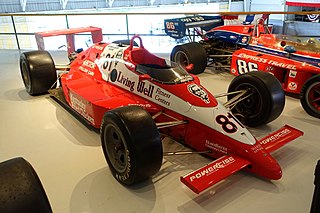
The March 87C is a highly successful and extremely competitive open-wheel race car, designed and built by March Engineering, to compete in the 1986 IndyCar season, alongside the 85C and 86C. The season was another whitewash and a clean-sweep for March, following up on the success of their 1986 campaign. The 86C chassis dominated the season, winning 9 out of the 15 races, and taking 8 pole positions. The March 87C chassis successfully clinched the 1986 IndyCar championship with Bobby Rahal, and the 1987 Indianapolis 500, with Al Unser. It was powered by the Cosworth DFX turbo engine like its predecessors.

The Watson Indy Roadster was an open-wheel race car chassis designed and developed by automotive mechanic and engineer A. J. Watson for U.S.A.C. Indy car racing, between 1956 and 1964.
The Eagle 68 was an open-wheel race car developed and built by Dan Gurney's All American Racers team, designed to compete in USAC IndyCar racing, starting in the 1968 season.












